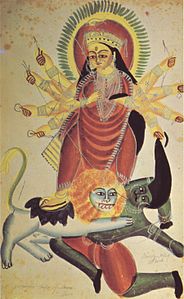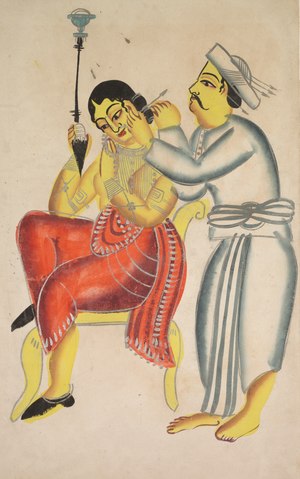Kalighat painting or Kalighat Pat (Bengali: কালীঘাট পটচিত্র) originated in the 19th century
 in West Bengal, India, in the vicinity of Kalighat Kali Temple, Kalighat, Calcutta, and from being items of souvenir taken by the visitors to the Kali temple, the paintings over a period of time developed as a distinct school of Indian painting. From the depiction of Hindu gods, god, and other mythological characters, the Kalighat paintings developed to reflect a variety of subjects, including many depictions of everyday life.
in West Bengal, India, in the vicinity of Kalighat Kali Temple, Kalighat, Calcutta, and from being items of souvenir taken by the visitors to the Kali temple, the paintings over a period of time developed as a distinct school of Indian painting. From the depiction of Hindu gods, god, and other mythological characters, the Kalighat paintings developed to reflect a variety of subjects, including many depictions of everyday life.
In the 19th century, the only school of painting that was flourishing in Bengal was the traditional art of scroll paintings that was popular in the rural areas. These paintings were done on cloth or patas. They depicted conventional images of gods and goddesses and scenes from epics like Tulsidas’ Rama Charita Manas. The artists were villagers who travelled from place to place with their scroll paintings and sang the scenes from the epics depicted in the paintings during village gatherings and various festivals. These artists, called patuas or ‘painters on cloth’.
The British: as patrons of this art
Initially, these artists were concentrated around the temple at Kalighat where there was a demand for religious art. Gradually, they have started to learn from the newer techniques and discovered that these could help them increase their earnings. They started creating new forms of art and the Kalighat painting was born.
Oriental and Occidental Kalighat

Another theme depicted, dear to the Bengali ethos, was that of Chaitanya Mahaprabhu and his disciples. But the Kalighat artists did not restrict themselves to religious themes. Their paintings depicting different professions and costumes were also popular with tourists. Even contemporary events like crime were the subject of many paintings. The artists also chose to portray secular themes and personalities and in the process played a role in the Independence movement. They painted historic characters like Rani Lakshmibai, and Duldul the famous horse of Imam Hussain of Karbala.
An important achievement of the Kalighat artists was that they made simple paintings and drawings, which could easily be reproduced by lithography. Such prints were then hand coloured. This trend continued up to the early part of the twentieth century and these paintings ended up in museums and private collections. The charm of the Kalighat paintings lies in the fact that they captured the essence of daily life and they influence modern artists like the late Jamini Roy even to this day.

